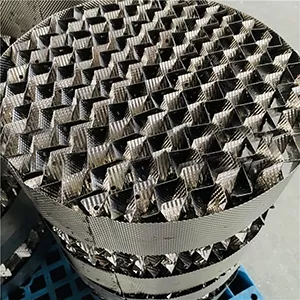How to Test the Wettability of structured packing?
The wettability of structured packing—its ability to be uniformly covered by liquid—is a critical factor influencing mass transfer efficiency in separation processes. Poor wettability can lead to uneven liquid distribution, reduced contact area, and lower separation performance. Several methods are commonly used to evaluate the wettability of structured packing, tailored to its material, structure, and application conditions.

Contact Angle Measurement
Contact angle measurement is a fundamental method to assess surface wettability. For structured packing materials (metal, ceramic, or plastic), a small sample of the packing sheet or corrugated layer is used. A droplet of the process liquid (e.g., water, organic solvents) is placed on the surface, and the angle between the liquid droplet and the solid surface is measured using a goniometer. A contact angle less than 90° indicates good wettability, as the liquid spreads readily over the surface; angles greater than 90° suggest poor wettability, with the liquid beading up and limiting contact. This method is quick, non-destructive, and provides quantitative data for comparing different materials or surface treatments (e.g., coatings to enhance wettability).
Liquid Spreading Test
This test evaluates how well liquid spreads across the structured packing’s surface under dynamic conditions, simulating real operating flows. A small section of the packing module is inclined at a typical operating angle (matching the corrugation slope, often 30° or 45°). A controlled volume of liquid is introduced at the top of the sample, and the spreading behavior is observed visually or recorded with high-speed imaging. Key metrics include the time taken for the liquid to cover the surface, the uniformity of coverage, and the presence of dry spots. For corrugated packing, special attention is paid to liquid distribution within the corrugated channels, as uneven spreading here can indicate poor wettability in specific flow paths.
Porosity and Capillary Rise Test
For porous or mesh-based structured packing, capillary action plays a role in wettability. The capillary rise test measures how far a liquid rises within the packing’s pores or mesh structure due to capillary forces. A vertical segment of the packing is partially submerged in the test liquid, and the height of liquid ascent over time is recorded. Faster and higher capillary rise indicates better wettability, as the liquid is drawn into the structure more effectively. This method is particularly useful for assessing wettability in fine-mesh or porous ceramic structured packing.
Dynamic Wettability in Pilot-Scale Columns
To simulate real industrial conditions, pilot-scale testing in a small packed column is conducted. The structured packing is installed in a test column, and liquid is distributed through a standard liquid distributor at typical flow rates. Pressure drop across the packing and liquid holdup (the volume of liquid retained in the packing) are measured. Higher liquid holdup and lower pressure drop inconsistencies often correlate with better wettability, as the liquid uniformly fills the channels without excessive channeling or bypassing. Additionally, visual inspection through transparent column sections can reveal dry areas or uneven coverage, providing direct evidence of wettability performance.
Surface Energy Analysis
Surface energy, the energy required to create a new surface, is closely linked to wettability. Techniques like inverse gas chromatography (IGC) or sessile drop analysis can quantify the surface energy of the packing material. Higher surface energy generally enhances wettability, as the solid surface has a stronger affinity for the liquid. This method helps identify whether poor wettability stems from low surface energy of the material itself, guiding material selection or surface modification (e.g., plasma treatment for metals, glaze adjustments for ceramics).
Considerations for Testing
- Liquid selection: The test liquid should match the actual process fluid, as wettability can vary with liquid properties (viscosity, surface tension, chemical composition).
- Material compatibility: Ensure the test liquid does not react with the packing material, as chemical interactions can alter wettability results.
- Temperature effects: Wettability may change at operating temperatures, so tests should be conducted at or near process temperatures when possible, using heated sample stages or temperature-controlled columns.
In summary, testing structured packing wettability involves a combination of surface analysis (contact angle, surface energy) and dynamic flow tests (spreading, column performance). These methods provide insights into how well liquid spreads and adheres to the packing, ensuring optimal design and material choices for efficient industrial separation processes.

